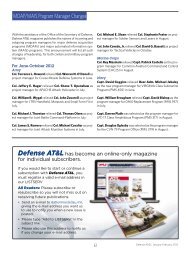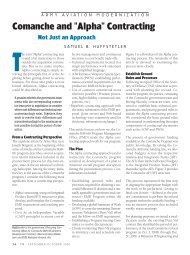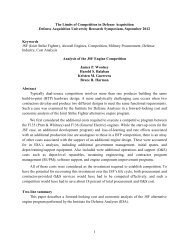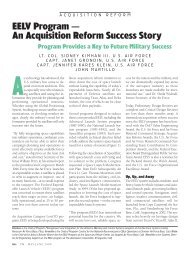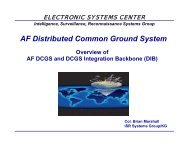Defense ARJ - Defense Acquisition University
Defense ARJ - Defense Acquisition University
Defense ARJ - Defense Acquisition University
Create successful ePaper yourself
Turn your PDF publications into a flip-book with our unique Google optimized e-Paper software.
systeM DoD WeaPon of systeMs DeVeloPMent<br />
ProGraMs<br />
integrated logistics information, and (c) to better logistics responsiveness to the joint<br />
warfighter (Staff Feature, 2003). As outlined in the 2006 QDR, the United States<br />
faces several types of dangerous threats. Logistics transformation, including the<br />
Future Logistics Enterprise, is needed in order to maintain technologically superior<br />
weapon systems for our well-deserving warfighter. Logistics matters have often been<br />
crucial in determining the outcome of wars.<br />
<strong>Defense</strong> life cycle ManaGeMent systeM<br />
The 2006 QDR described the need for continued transformation of acquisition<br />
and logistics processes in order to be more agile and more expeditionary, to increase<br />
reliability of DoD weapon systems, and to reduce logistics footprint. The defense<br />
life cycle management system is a total life cycle management system. Established<br />
by Department of <strong>Defense</strong> Instruction 5000.2, Operation of the <strong>Defense</strong> <strong>Acquisition</strong><br />
System, in May 2003 as a revised policy, the defense life cycle management system<br />
is a knowledge-based, phased, evolutionary process used for the acquisition of major<br />
defense weapon systems.<br />
The defense acquisition system uses a streamlined<br />
management process that delivers capable, reliable, and<br />
sustainable systems to the user.<br />
DoD has three major decision-making support systems to support the overall<br />
defense life cycle management system: (a) Planning, Programming, Budgeting & Execution<br />
(PPBE); (b) Joint Capabilities Integration and Development System (JCIDS);<br />
and (c) <strong>Defense</strong> <strong>Acquisition</strong> System. These three systems use an integrated approach<br />
for strategic planning, identification of military capabilities’ needs, system acquisition,<br />
and program and budget development. The three support systems work together<br />
simultaneously while the phases are carried out throughout the life cycle.<br />
The PPBE is DoD’s primary resource allocation process. The PPBE has three objectives.<br />
First, it is a biennial, calendar-driven process used for obtaining funding for<br />
major weapon systems acquisition. Second, it provides a factual basis for affordability<br />
assessment and resource allocation decisions. Third, it offers a formal structured<br />
system for making decisions on policies, strategies, prioritized goals, and the development<br />
of necessary forces and capabilities to accomplish DoD’s various missions.<br />
The JCIDS is dependent on warfighting deficiencies or needs. It assesses mission<br />
requirements and strategies for meeting those requirements as well as providing the<br />
basis for establishing priorities (DAU, ACQ-101, Lesson 2).<br />
The defense acquisition system uses a streamlined management process that<br />
delivers capable, reliable, and sustainable systems to the user. It is an event-driven,<br />
199



